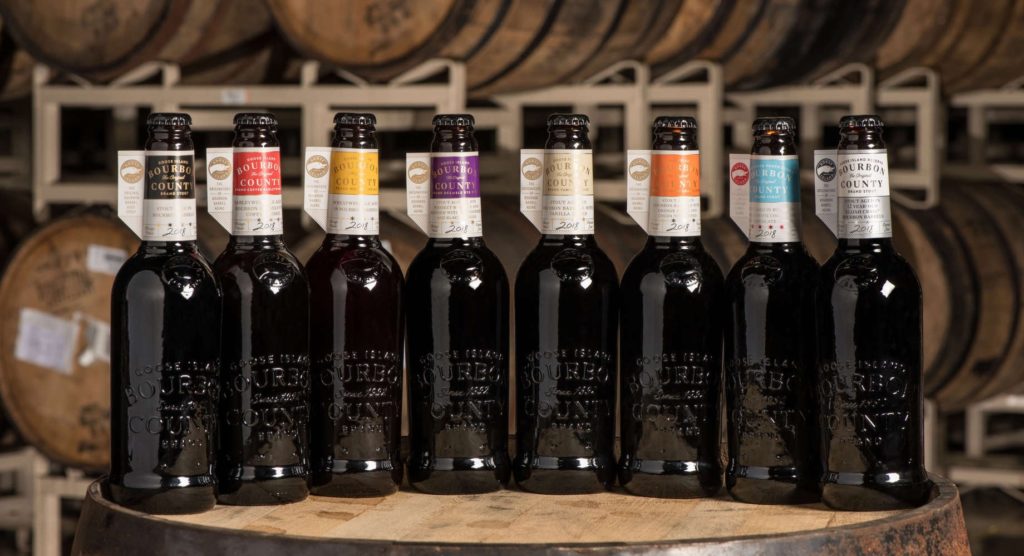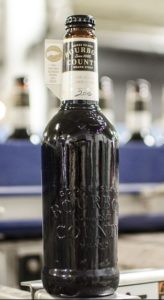
(This story was written by Jeff Alworth for All About Beer Magazine, 2016)
Beer aged in bourbon barrels is an innovation not unlike the internet—it’s almost impossible to imagine a time before each existed. And yet it was only relatively recently, in the mid-1990s, when breweries even considered such a strange thing as putting beer inside discarded bourbon barrels—about the time we started sending emails over our AOL accounts.
The story began, unexpectedly, at a beer, bourbon and cigar dinner at LaSalle Grill in South Bend, Indiana. The still-small Goose Island brewpub, one of the co-hosts, came with growlers of beer (the brewers weren’t bottling yet). “And then representing bourbon,” Goose Island’s Greg Hall recalls, “was Booker Noe himself, the master distiller from Jim Beam.” Noe was Jim Beam’s grandson and a legend in the business. According to accounts from both Hall and Seth Gross, another Goose Island brewer who was in attendance, Noe was incredibly engaging and charming. Gross (now with Bull City Burger and Brewery in Durham, North Carolina) remembers one story in particular, when, after emptying a barrel, “they would fill it with a couple gallons of spring water and roll it around in the yard, drain that, and put it in a tall iced-tea glass with a bunch of ice. They drank it like iced tea at the end of the day.” By the end of evening, the first seed of the idea of aging a beer in one of Noe’s barrels had been planted.
 The rest is almost history. Greg Hall would go on to brew a beer to go into those barrels, and that beer was the imperial stout that became Bourbon County Brand Stout. There are two, little-observed, important historical facts in this story. The first is that Hall was already thinking about a way to celebrate the brewery’s thousandth batch of beer, and he wanted to do something special. The second is that the beer he chose was an imperial stout. Decades later, we know that stout goes with bourbon like cherries go with lambic, but at the time, Hall and his brewers were just taking a guess. Imagine if they’d put a pale ale in there.
The rest is almost history. Greg Hall would go on to brew a beer to go into those barrels, and that beer was the imperial stout that became Bourbon County Brand Stout. There are two, little-observed, important historical facts in this story. The first is that Hall was already thinking about a way to celebrate the brewery’s thousandth batch of beer, and he wanted to do something special. The second is that the beer he chose was an imperial stout. Decades later, we know that stout goes with bourbon like cherries go with lambic, but at the time, Hall and his brewers were just taking a guess. Imagine if they’d put a pale ale in there.
Of all the uses of bourbon barrels, none seems more harmonious than putting a stout inside. It’s one of the few styles that can use the hint of age and oxidation barrel-aging provides, turning the rougher, acrid edges of roasted malts into portlike flavors. Adding a taste of that sweet whiskey further rounds out the experience. Since that first batch from Goose Island, breweries have made hundreds of barrel-aged stouts, but few can match the original’s strength or intensity. It’s brewed to 13%, a level that leaves a huge amount of residual sugars for a dense, velvety mouthfeel. Hall recalled that the first batch finished out at 10 degrees Plato (1.040)—enough leftover maltose to create an entirely separate 4% beer.
Another fascinating feature is the aging and blending. Now that Bourbon County has become such a phenomenon, the brewery has to produce it over a series of months. That means that each vintage contains beer ranging from 8-15 months in age. Because Goose Island’s barrel warehouse doesn’t use any heating or cooling, the beer goes through substantial temperature swings between Chicago’s hot summers and frozen winters. Bill Savage, the lead brewer of the barrel-aging program, says that’s an advantage. “We want the cold to make the wood contract; we want the humidity and the heat [to] make it swell so that all that liquid is getting plenty of movement in the wood. It makes it age considerably faster. You pick up a lot more higher-alcohol, fusel notes. It helps mature it a little bit faster.”
Of course, it can also help nurture wild yeasts and bacteria, a lesson Goose Island learned the hard way after its 2015 release. Somewhere along the line, the beer picked up a tiny amount of Lactobacillus acetotolerans—not enough that the brewers found it when testing the beer in the lab, but enough to grow in the bottle, sour the beer, and require a recall. (The brewery recently announced that, for the first time, it would begin pasteurizing the Bourbon County line.)
Bourbon County Brand Stout seems to have evolved a bit over the years. I have found some vintages to be sweet to the point of cloying. Perhaps because of the new barrel room, recent bottles have been more balanced; there are notes of medium-roast coffee and dark chocolate to contrast the sweeter notes of alcohol, vanilla and coconut. I may be suggestible, but Savage’s mention of fusel alcohol brings my attention to spikier flavors buried deep within those folds of chocolate, something like tobacco or licorice.
There’s one more wrinkle to the story of this seminal beer. Goose Island dates the original batch to 1992, but Hall admits that was always a guesstimate; the original brewing log has been lost. Hall arrived at 1992 by triangulating between a few events. “It wasn’t ’91 and it wasn’t ’95, so it had to be ’92, ’93 or ’94.” Seth Gross can improve on this window, though. He was at that original beer dinner, but “I started at the end of 1993, maybe ’94.” That means it was almost certainly 1994, not ’92. Regardless of the year, one thing no one disputes is how influential this beer was. Even adjusting the date to 1994, it was the original bourbon-barrel-aged beer and set the course for all those that would come later.